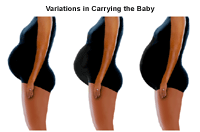The Third Trimester
Prenatal visits during the third trimester
During the second and third trimester prenatal visits, your healthcare provider may
check the following things. Exactly what they check depends on your current health
condition and the health of the fetus:
-
Any current symptoms or discomforts
-
Your weight
-
Your blood pressure
-
Your urine for a protein called albumin that may be a sign of preeclampsia or toxemia,
and sugar that may be a sign of hyperglycemia
-
Position, growth, and development of the fetus
-
Height of the top of the uterus (fundus)
-
Fetal heartbeat
As you start the third trimester, your healthcare provider or midwife may change the
schedule of your prenatal visits from every month to every 2 weeks. Your visits may
be scheduled once every week in the last month. This schedule will be based on your
health condition, the growth and development of the fetus, and your provider's or midwife's
preference.
At about the 38th week of the pregnancy, your provider will do a pelvic exam to find
out the dilation and effacement of the cervix. Your provider or midwife will ask about
any contractions. They will also talk with you about labor and delivery procedures.
What to expect during the third trimester
The third trimester marks the home stretch as you get ready for the birth of your
baby. The fetus continues to grow in weight and size, and the body systems finish
maturing. You may feel more uncomfortable now. You will continue to gain weight and
begin to have false labor contractions (Braxton-Hicks contractions).
During the third trimester, it's a good idea to start taking childbirth classes to
get ready for the big day. This is especially true if this is your first pregnancy.
Breastfeeding is best for your baby. Talk with your healthcare provider about the
benefits of breastmilk.
During the third trimester, both your body and the fetus continue to grow and change.
Fetal development during the third trimester
During the third trimester, the fetus continues to grow in size and weight. The lungs
are still maturing. The fetus starts to position itself head-down. By the end of the
third trimester, the fetus is about 19 to 21 inches long and weighs about 6 to 9 pounds.
Fetal development during the third trimester includes:
-
The fetus can see and hear.
-
The brain continues to develop.
-
The kidneys and lungs continue to mature.
-
By the 36th week, the head may drop into the pelvic area (engage). This is a process
called lightening.
-
The bones of the skull stay soft to make it easier to pass through the birth canal.
-
For many babies, the irises of the eyes are slate blue. The permanent eye color will
not appear until several days or weeks after birth.
-
The fetus can suck its thumb and can cry.
-
By 38 to 40 weeks, the fetus's lanugo has almost all gone away.
-
By 38 to 40 weeks, the lungs have matured fully.
-
The baby is covered in vernix caseosa (or simply called vernix). This is a creamy,
protective coating on the skin.
-
The head will often turn downward during the last couple of weeks of pregnancy.
Changes in your body
In the third trimester, you may become more uncomfortable as your due date nears.
As the fetus grows in size and crowds the abdominal cavity, you may have a hard time
taking deep breaths or getting comfortable at night for sleep. Or you may not have
any discomfort as you anxiously await the arrival of your new son or daughter.
Here is a list of changes and symptoms that you may have during the third trimester:
-
Increased skin temperature, as the fetus radiates body heat, causing you to feel hot.
-
Need to urinate more often because of increased pressure on the bladder.
-
Swelling of the ankles, hands, and face (edema) as you keep retaining fluids.
-
Hair may start to grow on your arms, legs, and face because hormones are stimulating
the hair follicles. Your hair may also feel coarser.
-
Leg cramps may happen more often.
-
False labor (Braxton-Hicks contractions) may start at irregular intervals in preparation
for childbirth.
-
Stretch marks may appear on the stomach, breast, thighs, and buttocks.
-
Colostrum may start to leak from your nipples. This is a fluid in the breasts that
nourishes the baby until the breastmilk becomes available.
-
Dry, itchy skin may continue, particularly on the stomach. This is because the skin
continues to grow and stretch.
-
Your sexual drive may drop.
-
Skin pigmentation may become more apparent. You may have dark patches of skin on your
face.
-
Constipation, heartburn, and indigestion may continue.
-
White-colored vaginal discharge (leukorrhea) may increase and contain more mucus.
-
Backaches may continue and get worse.
-
Hemorrhoids may continue and get worse.
-
Varicose veins in the legs may continue and get worse.

As shown above, each person carries their baby differently. It depends on their body
structure and amount of weight gain.